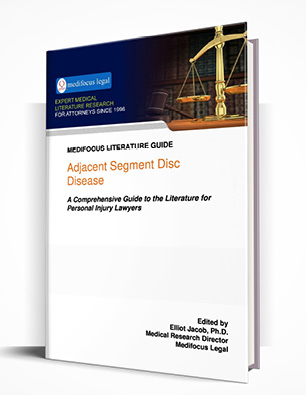Adjacent Segment Disc DiseaseA Comprehensive Guide to the Literature for Personal Injury Lawyers
Publisher: Medifocus Legal
Publication Date: June 19, 2022
Number of Pages: 152
A Comprehensive Guide to the Literature for Personal Injury Lawyers
Publisher: Medifocus LegalPublication Date: June 19, 2022
Number of Pages: 152
Although the exact cause of adjacent segment disease is currently not known, three major risk factors have been identified: 1) the natural history of normal, age-related disc degeneration; 2) increased biomechanical stress with increased motion on the next-level disc from the fusion surgery; and 3) anatomical disruption of the vertebral segment at the next-level disc resulting from the fusion.
Currently there is no gold standard treatment for adjacent segment disease and the treatment options are primarily dependent upon the severity of the clinical symptoms. Treatment can be challenging, particularly in cases with significant neurologic symptoms and instability that fail to respond to conservative treatments such as physical therapy. In this setting, revision surgery may be necessary to relieve the symptoms by decompressing the affected spinal nerve roots with possible extension of the fusion to additional levels.
The MediFocus Literature Guide to Adjacent Segment Disc Disease is a comprehensive reference guide to the medical literature for personal injury attorneys whose clients may have developed adjacent segment disease after cervical or lumbar fusion surgery. This unique Guide consists of over 190 hand-selected references published in peer-reviewed journals with links to the Abstracts of all of the articles. It also includes links to the FREE full-text of 39 articles. This valuable Literature Guide captures the broad spectrum of clinical and scientific knowledge about adjacent segment disc disease that has been accumulated over the past decade.
 |
- A comprehensive bibliography of 266 journal article references indexed in MEDLINE published in well respected medical and scientific journals.
- Online access to the abstracts (summaries) of the articles.
- Online access to the free full-text version of 39 articles.
- Links to full-text sources of other articles that are available for purchase directly from individual journal publishers.
- A unique "Author Directory" consisting of the names and institutional affiliations of experts who have published and have specialized knowledge about Adjacent Segment Disc Disease. The "Author Directory" is a valuable resource for quickly identifying and locating experts for case reviews, opinions, and testimony.
Select examples of topics that are covered by the articles referenced in this Guidebook include:
- Demographic, clinical, and operative risk factors associated with postoperative adjacent segment disease in patients undergoing lumbar spine fusions: a systematic review and meta-analysis.
- Adjacent-Segment Disease Following Spinal Arthroplasty. A Review
- Risk factors for adjacent segment degeneration after posterior lumbar fusion surgery in treatment for degenerative lumbar disorders: a meta-analysis.
- Factors of Adjacent Segment Disease Onset After Microsurgical Decompression for Lumbar Spinal Canal Stenosis.
- Adjacent Segment Reoperation and Other Perioperative Outcomes in Patients Who Underwent Anterior Lumbar Interbody Fusions at One and Two Levels.
- Factors Predictive of Adjacent Segment Disease After Lumbar Spinal Fusion.
- Prognostic Factors for Adjacent Segment Disease After L4-L5 Lumbar Fusion.
- Risk factors of second surgery for adjacent segment disease following anterior cervical discectomy and fusion: A 16-year cohort study.
- Adjacent segment disease after posterior lumbar instrumentation surgery for degenerative disease: Incidence and risk factors.
- Adjacent segment degeneration after fusion spinal surgery-a systematic review.
- Multiple-Repeated Adjacent Segment Disease After Posterior Lumbar Interbody Fusion.
- Risk factors associated with clinical adjacent segment pathology following multi-level cervical fusion surgery.
- Effectiveness of Reoperations for Adjacent Segment Disease Following Lumbar Spinal Fusion.
- Cervical canal stenosis and adjacent segment degeneration after anterior cervical arthrodesis.
- Adjacent segment pathology requiring reoperation after anterior cervical arthrodesis: the influence of smoking, sex, and number of operated levels.
- Impact of body mass index on adjacent segment disease after lumbar fusion for degenerative spine disease.
- Risk factors for predicting symptomatic adjacent segment degeneration requiring surgery in patients after posterior lumbar fusion.
- Repeated adjacent-segment degeneration after posterior lumbar interbody fusion.
- Risk factors of adjacent segment disease requiring surgery after lumbar spinal fusion: comparison of posterior lumbar interbody fusion and posterolateral fusion.
- Adjacent segment disease after anterior cervical discectomy and fusion: clinical outcomes after first repeat surgery versus second repeat surgery.
is available in two formats: | |
Order by Phone:To order by phone, please call: Order by Mail:To order by mail, please print and complete this Order Form | |

